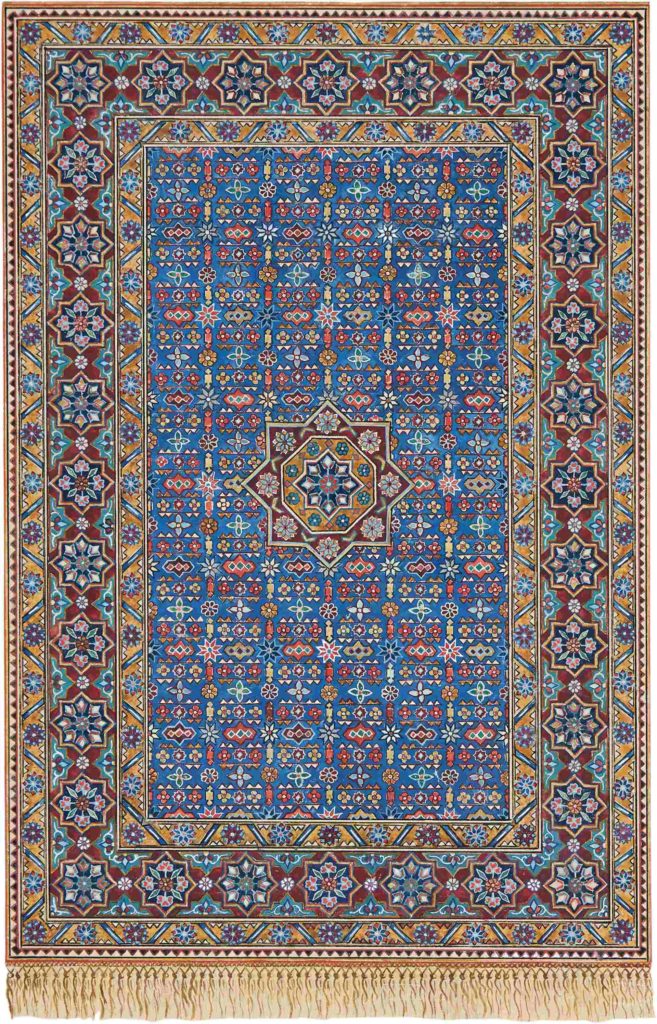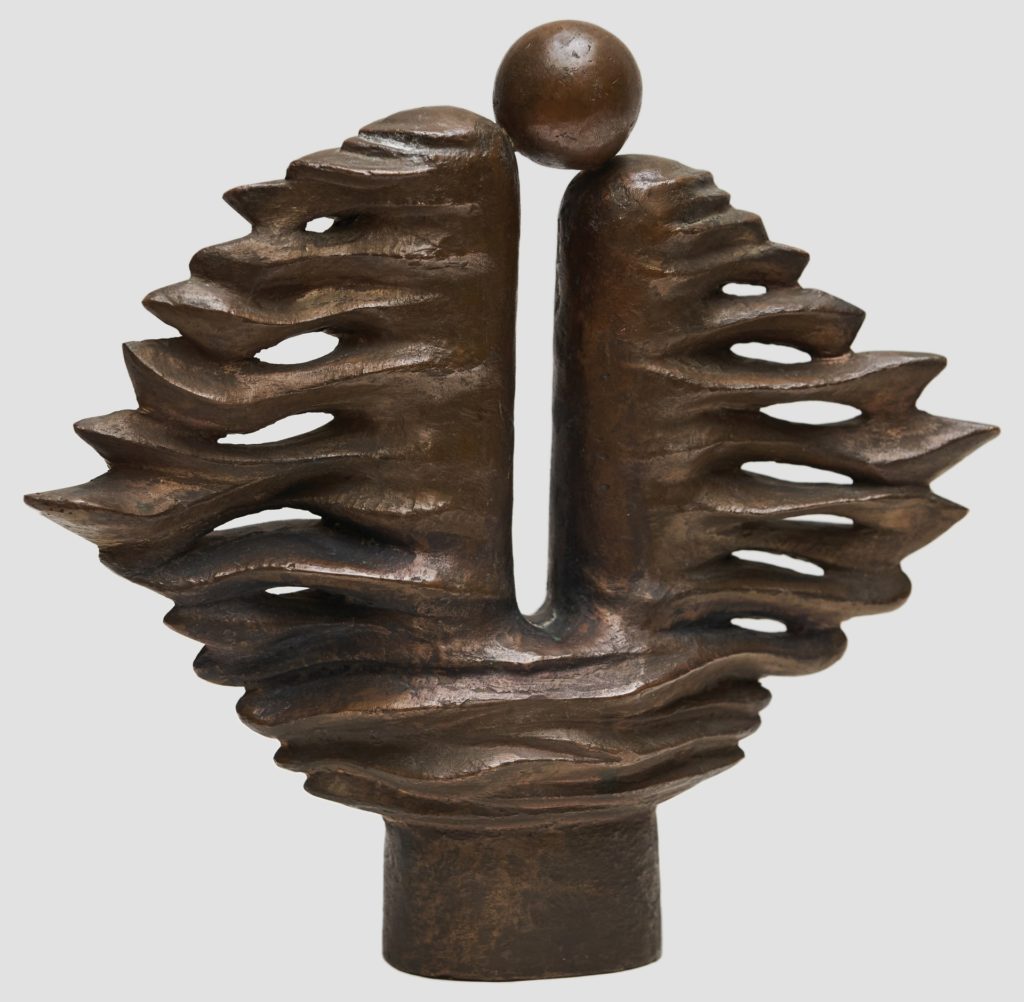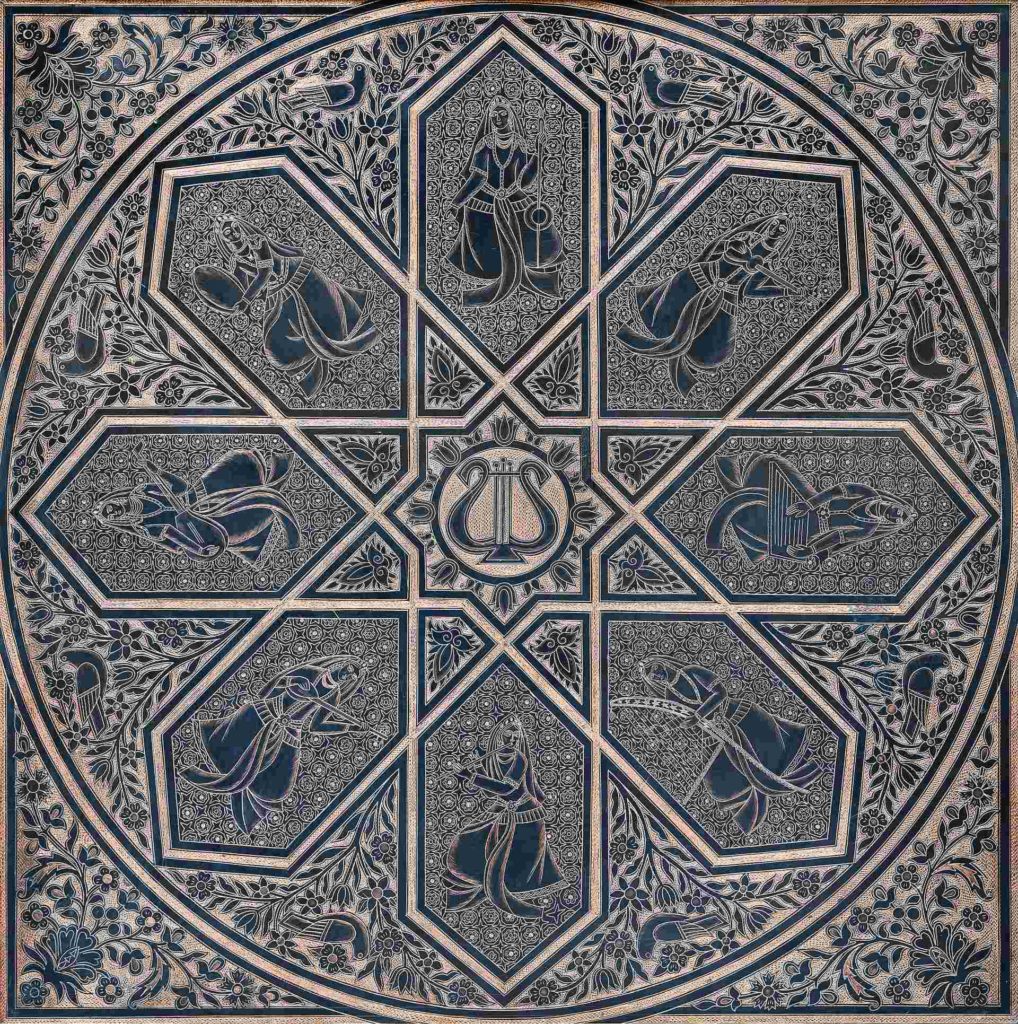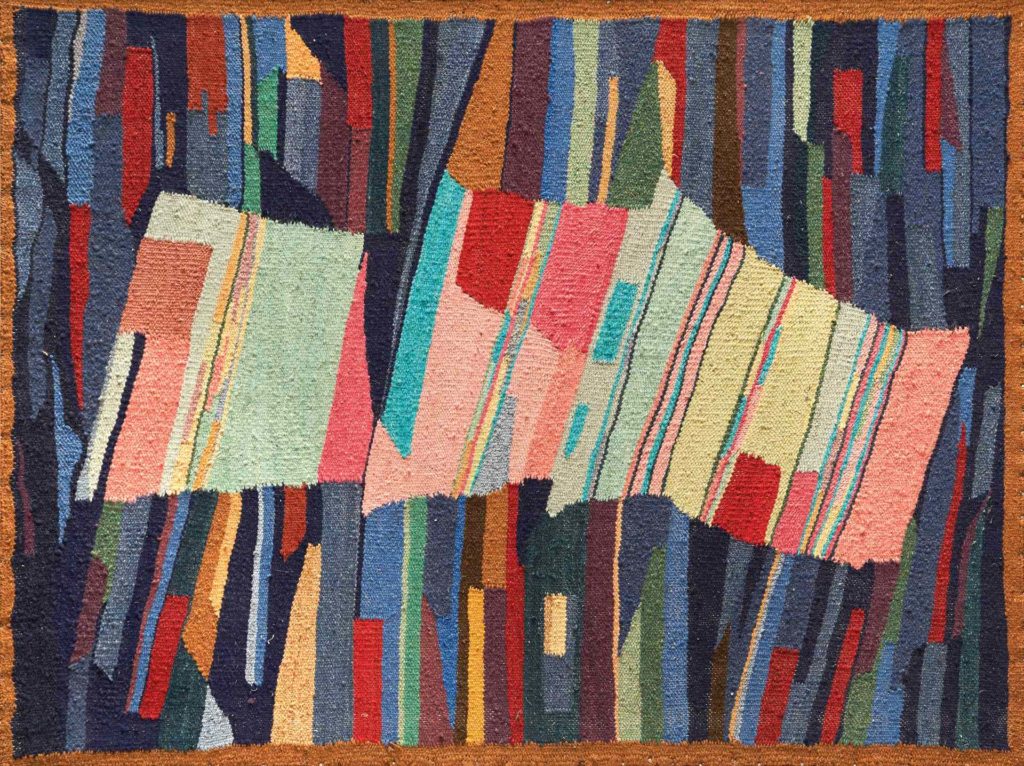Modern decorative and applied arts of Azerbaijan are rooted in deep antiquity. Ceramic products, metal artwork (weapons, dishes, jewelry), woodcarving, carpet weaving and the production of various fabrics, sericulture and silk painting – all these do not just make up the rich spiritual heritage of the Azerbaijani people. Once formed in the territory of Azerbaijan at the dawn of human race all these types of crafts developed and improved over the centuries, that was facilitated by climatic and natural conditions, as well as the lifestyle of certain tribes and nations – the ancestors of Azerbaijanis.
History contains a lot of evidence of merchants and travelers who visited Azerbaijan and admirably described the production of local craftsmen. Therefore, it is not surprising that there is a variety of forms, materials, colors and patterns that distinguishes Azerbaijani decorative and applied art today. Folk craftsmen, as well as the artists working in this field of arts, are cultivating, up to now, the forms polished by ages as they are completely organic in their unity of functional and aesthetic properties.
However, being a living organism, the modern applied arts of Azerbaijan not only sacredly honour centuries-old traditions, but also sensitively respond to the demands of our time, as no other kind of arts is connected with a person, and his/her living environment, in such extent like this one. The artists in this field of art create objects, directly called to ennoble this very environment. The matter here is not only about aesthetic expressiveness. The forms that have been elaborated over the centuries, along with their ornamental component, carried enormously a ritual significance. Having been developed from elementary geometric patterns, that were gradually getting more and more complicated, acquiring the additional details and interweaving with floral and animalistic motives, the ornamental system of the Azerbaijani carpets and carpet products as well as ceramic and copper utensils, weapons and pieces of jewelry, ultimately formed a holistic language of characters and signs. This language is recognizable for craftsmen, who are passing on from one generation to another not only their professional skills, but also this enigmatic knowledge, a spiritual component, without which a human life is unthinkable.
This language is a lore wisdom, the deep meaning gained as a result of long–term practice and the rich life experience. Modern artists working in traditional forms of applied arts, in their desire to evolve the artistic language or technology, as if enchanted, again and again apply the approved through the ages and repeatedly “voiced” motifes, which are built on filigree ratio of the parts and the whole. Those motifes carry an inner beauty, “peeped” at nature, and never leave the territory of harmony.
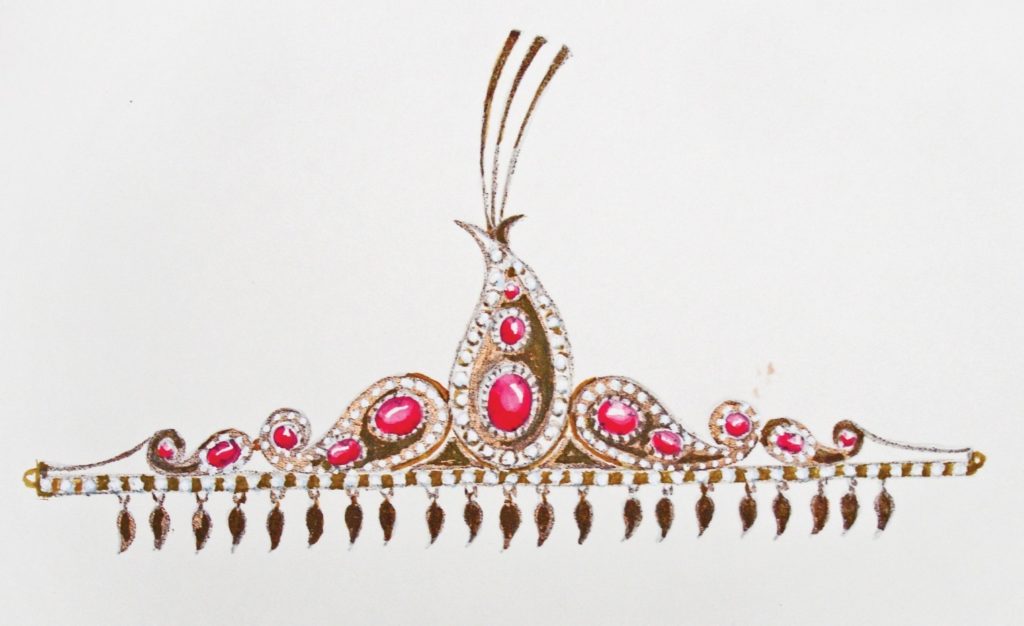
Paper, gouache. 20×28 cm
The funds of the Azerbaijan State Art Gallery store more than 130 items of decorative and applied arts. Here are presented such types and materials as porcelain, ceramics and glass, art woodworking and metalworking, carpets and carpet products, kelagai (the national kind of silk scarf), batik, and finally – jewelry. There are also kept the modern installations, whose artistic expressiveness is based on the use of the latest technologies, for example, a combination of polyester, copper and acrylic paints. The widespread techniques and usage of the historically established principles of shaping and decoration are side by side with a renovated interpretation of the topics typical for this locus, as well as bold attempts to innovate the language of expressiveness and to search for new solutions within traditional kinds.
Only some examples of the above are represented in this portal. But even these few examples allow us to judge the variety of formal and artistic searches of Azerbaijani artists. For example, in the work “Icherisheher”(“Inner town”, the fortress, which is the initial, the ancient part of Baku city) made in the technique of batik, the author (A. Ibrahimov) completely abandoned the generally accepted reading of the look of the Baku fortress – a motive extremely popular in the works of Azerbaijani painting and graphics. A feeling of belonging to this genuine open-air museum of the history of Baku, of Azerbaijan, of the Azerbaijani nation the artist conveyed is expressed by using the purely formal artistic means. An enlightened range of colors creates a romantic mood. The barely outlined cubic character of the architectural forms of the Shirvanshahs palace turns into planar geometric representation, thereby affirming the ephemeral character of the whole image. The proposed view of Icherisheher looks like a beautiful dream, where the various “values” of the national culture are brought together – both the striking patterns and the complexity of ornaments of the tiles on the monuments of Azerbaijani cult architecture, and the contrasting forms of the constructions of the Shirvan-Absheron architectural school, the expressiveness of which is entirely based on proportionality and harmony of the volumes ratios, as well as the quality of the masonry. Finally, the sophisticated color range, based on the nuances, proper to the Medieval Azerbaijani miniature also comes to one’s mind in perception of this art.
All this testifies to the author’s creative, individual approach towards the popular motifes and traditions of the past of the Azerbaijani culture, when the artist manages to achieve an absolutely fresh sound of well-known images. The square format of work by itself creates a sense of stability, peace, eternity, as if it visually affirms the thought: yes, the years go by, but the “inner city” is young as ever, and life has gone on and on, and will go on…
Another undoubtedly attractive work in batik technique is the composition “Simurgh” by Inna Kostina. As such, this image is quite ambiguous. Relating to the mythology of many countries and peoples, – and primarily within the context of Persian culture, then transferring to Turkic peoples, Scythians, Sarmatians, and even Slavs, – it was usually depicted as a fantastic winged creature with the head and legs of a dog, while the body was covered with fish scales. These features were to indicate Simurgh’s power on Earth, in Air and in Water. In the tales devoted to Simurgh, this immortal bird lived within the branches of the Tree of Knowledge, its plumage was usually described as overshadowing the luster of the pheasant and peacock feathers. Simurgh was endowed with an ability to heal, sometimes it acted as a tool of fate and it was credited with immortality. The image of Simurgh is also present in Sufism, where it symbolizes a Perfect Man gifted with knowledge of the Divine Essence. Literally meaning in Persian “thirty birds”, this image often symbolizes the unity, the knowledge, and, above all, the self awareness.
In the interpretation of I. Kostina, this royal bird, presented in a female image, is dressed in gold-painted clothes, covered with totem signs and symbols. The colors of this work are striking: the hot purple of the background signifying a supreme power is combined with the cold violet-blue tones of clothes, creating a specific feeling of the spicy aftertaste of the East, the presence of Mystery, that frightens and attracts at the same time. It is significant that the artist has not followed the path of illustrating the generally accepted description of a syncretic creature sparkling with its plumage; however, the whole polyphony of those intonations and shades that this image is endowed with in different cultures is present in the image created by I.Kostina.
An interesting example of the interpretation of the national traditions is the panel by S. Mammadov and E. Ahmedov “Azerbaijan’s support to the front”. The engraving technique reproduces the image of the Azerbaijani carpet. The central field, consisting of two medallions in the form of girih (one of the most common patterns in Islamic Architecture and Applied arts), is a juxtaposition of the architectural images of the historical Baku – the architectural monuments of Icheri Sheher, and the modern Baku, where the well-recognizable buildings are closely intertwined with industrial objects.
Each of the works shown here is capable of creating an endless chain of associations, thoughts, emotions in the viewer. For example, the tapestry of U. Aliyeva “Consolidation” refers to the style of avantgarde painting, without losing the purely decorative expression that is so important for this type of art. The clear rhythm of multi-colored vertical modules excites, ultimately forming a kind of a “life formula”. It is a plasmoid before us, a certain entity charged with the strongest energy. It seems that the force locked inside of it is about to “shoot”, as it happens with an extremely compressed spring.
The conceptual composition “Memory” by L. Isgandarzade made of chamotte creates a certain image of the matrix, which seems to “decay” right before the eyes of the viewer and then is filled again with a new content – the “chips”, the clots of feelings, emotions, everything that we had experienced, but still remains an important component of our psyche…
A favorite and extremely popular motif in Azerbaijani art is a pomegranate bush and its fruit. Despite the fact that this fruit grows in many regions of the world, it is especially popular and much loved in Azerbaijan. They say that it is only in Azerbaijan one can find all the existing sorts of this plant. It is impossible to list all still lifes of Azerbaijani artists, where the pomegranate is one of the main characters. And what about numerous dishes of Azerbaijani cuisine, where the pomegranate grains or juice have a special place!
This sturdy, shimmering with ruby color fruit, by virtue of its external qualities, certainly attracts the masters of Decorative and Applied arts. There are a great many works in the Gallery’s collection – the ceramic decorative compositions, painted dishes, glass vases, embossing, jewelry – where the pomegranate plays a central formative and iconic role. One would like to note here the volumetric decorative composition of N.Gojamanly, in which this precious fruit of Azerbaijan is interpreted as a kind of treasure trove: the cubistic form of a pomegranate is cut in half, and individual grains “roll out” from its womb like a precious filling of the Simsim Cave.
About 100 authors are represented by their works in the Department of Applied arts and Crafts of the Gallery. But there are names that cannot be ignored, for these are the names of the lumi-naries of the Azerbaijani culture, the figures that are significant not only for Azerbaijani art, but for the history of Azerbaijan too.
One of them is the name of Latif Kerimov, the legendary Azerbaijani carpet scholar, an author of a great number of original carpets, a brilliant connoisseur of the Azerbaijani mugham. They say that he used to compose the lyrical goshma (the ancient form of the Azerbaijani poetic genre, mainly used in ashug poetry) to help his students, who were not literate enough and had problems in taking notes, to remember the rules of weaving techniques. In addition to carpets, L. Kerimov successfully worked with jewelry. He was engaged in wood carving, and the interior decorating. It is difficult to overestimate his role in renewal of the ornamental carpet system. But his main merit to the fatherland is that, as a result of many years of painstaking work, he formulated the criteria of the Azerbaijani carpet school, thereby giving back “nationalism” to 90% of the carpets stored in the museums around the world under the “foggy” definitions of “Persian” or “Oriental”, or – “Caucasian” ones. The sketches of patterns presented in this section and produced by Latif Karimov, allow to measure the uniqueness of his gift as of a master of color and ornament.
Another name that is extremely important for the Azerbaijani culture of the 20th century is Badura Afganli, who devoted her entire creative life to the Azerbaijani theater, cinematography, and dance. Among the sketches of costumes created by B. Afganly that are stored today in the collections of the State Gallery, there are also the sketches of jewelry. The delicate relationship with the forms that have been established for centuries is organically combined here with an individual, the author’s interpretation of the traditional motifs.
Preserving the heredity, the relation of generations, that is especially important in the field of Decorative and Applied arts as being a receptacle of the “genetic code” of the national culture – that is the main task that the museum collections, including the Azerbaijan State Art Gallery, are facing.
